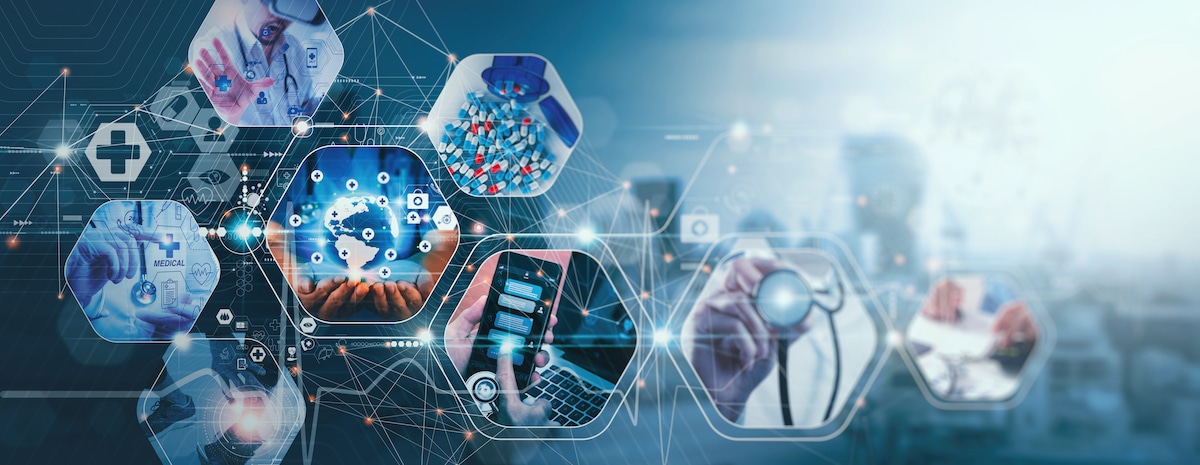IoT in Healthcare: Security Risks and Patient Privacy

The Internet of Things (IoT) has become a vital part of the healthcare industry, greatly impacting patient interaction and treatment. These connected devices collect and transmit patient data, allowing providers to monitor and manage patient health more effectively. However, the widespread adoption of IoT in healthcare exposes the industry to new risks, leading to a surge in security threats.
A 2023 SonicWall Cyber Threat Report shows that malware attacks against IoT in the medical field increased by 123% in 2022. The result is a significant threat to the privacy and safety of patient information.
Data Collection Through IoT in Healthcare
IoT devices are now nearly ubiquitous in the medical field, collecting patient information to improve diagnosis, treatment and overall care. Some of the most common types of data collected are:
- Vital signs– IoT devices can continuously monitor patients’ heart rate, blood pressure, oxygen saturation and other vital signs, allowing healthcare providers to track real-time health status.
- Activity levels– Wearables and sensors track patients’ movements and activities, providing insights into daily routines, exercise habits and sleep patterns.
- Medical device data– Connected devices, such as insulin pumps and pacemakers, transmit data on their operation and status, enabling doctors to monitor performance and make necessary adjustments remotely.
- Health history– Electronic health records (EHRs) store patients’ medical histories, including previous diagnoses, treatments and medications. Providers can access and update this information, improving care coordination and decreasing the risk of errors.
Healthcare IoT Security Risks and Protecting Patient Data
This significant increase in IoT malware attacks against the healthcare sector is particularly concerning when viewed in the context of a Cynerio 2022 State of Healthcare IoT Device Security report. This study revealed that 53% of hospital IoT devices have security vulnerabilities. Devices that fell into the most vulnerable category included IV pumps, VoIP phones, ultrasounds, medicine dispensers and IP cameras.
These weaknesses pose significant risks to both patients and healthcare providers. One primary risk is data breaches. Cybercriminals exploit IoT security vulnerabilities to gain access to sensitive patient data, leading to identity theft, fraud or other malicious activities.
Another risk is ransomware, where attackers can encrypt patient data and demand payments in exchange for release. These attacks can disrupt healthcare operations and in extreme cases potentially endanger patients’ lives.
Device manipulation is an additional security risk. Cyberattackers can compromise IoT devices, altering their functionality and putting patients in jeopardy of receiving incorrect treatments or experiencing adverse health events. This type of threat not only endangers patient safety but can also undermine faith in the healthcare system as a whole.
Safeguarding Patient Information with Security Best Practices
To safeguard patient data and maintain the advantages of IoT devices in healthcare, healthcare providers must take a proactive approach to implementing security measures. These include:
- Periodically reviewing IoT devices to identify potential vulnerabilities and prioritize security updates.
- Encrypting patient data at rest and in transit to safeguard it against interception and unauthorized access.
- Implementing robust authentication methods, such as two-factor authentication, helps protect IoT devices and ensure only authorized personnel access patient data.
- Healthcare providers should work closely with IoT device manufacturers and software vendors to promptly apply security patches and updates.
- Providers must ensure staff are well-versed in cybersecurity best practices. Knowing the risks associated with IoT devices is crucial in creating a culture of security awareness.
- Developing a comprehensive incident response plan helps healthcare organizations quickly identify, contain and remediate security breaches, minimizing their impacts.
- Healthcare providers must comply with industry-specific regulations, such as HIPAA, which sets strict criteria for safeguarding patient data and protecting privacy.
Building a Secure Future for IoT in Healthcare: Partnering for Success
IoT devices have transformed the healthcare sector, providing real-time data that enables providers to manage patient health more efficiently and effectively. However, the growing reliance on connected devices presents unique challenges in ensuring the privacy and safety of patient information. By implementing robust security measures and maintaining a proactive approach to risk management, healthcare organizations can harness the benefits of IoT technology while safeguarding the trust and well-being of their patients.
Securing your IoT devices, while extremely important, is just one part of healthcare security. OneNeck recognizes the critical nature of securing patient data and is dedicated to offering holistic security services that adhere to the strictest compliance standards. By partnering with OneNeck, healthcare organizations can update legacy systems, implement securely architected cloud solutions, design and implement robust backup and DR services, develop incident response plans and ensure continuous alignment with regulatory requirements.
Ready to talk to a security expert? OneNeck is here to help. Contact us today to discuss how you can better protect sensitive patient data and maintain a secure and healthy environment.
Additional Resources:




